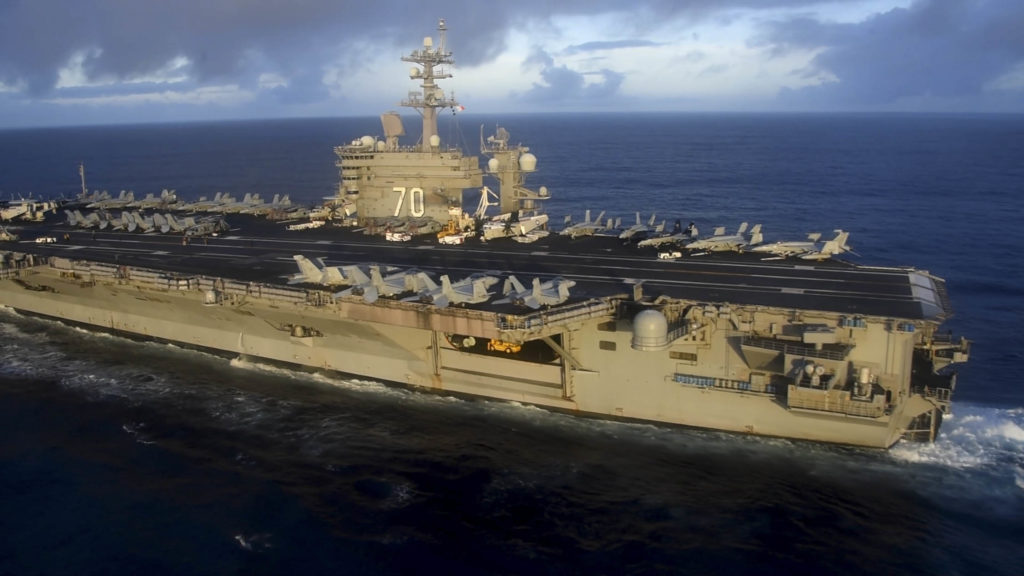
A video grab of the USS Carl Vinson on patrol
ABOARD THE USS CARL VINSON—With a deafening roar, the fighter jets catapulted off the USS Carl Vinson and soared above the heavily disputed South China Sea, as the aircraft carrier’s admiral vowed that the mighty warship’s presence was proof the United States still had regional clout.
“US presence matters,” Rear Adm. John Fuller told reporters on board the aircraft carrier. “I think it’s very clear that we are in the South China Sea. We are operating.”
The Carl Vinson, one of the US Navy’s longest-serving active carriers, is currently conducting what officials say is a routine mission through the hotly contested waters where years of artificial island building and military construction by China has rattled regional nerves.
Filipino guests
Following criticism that the Trump administration’s commitment to the Asian region has been distracted by North Korea, the US Embassy in Manila flew Philippine officials and journalists onto the carrier on Wednesday as it sailed through the South China Sea.
The officials were Executive Secretary Salvador Medialdea, Communications Secretary Martin Andanar, Philippine Marine Corps Commandant Maj. Gen. Alvin Parreño and Philippine Fleet Commander Rear Adm. Gaudencio Collado.
The group also included officials from the Department of Foreign Affairs.
The press group included a reporter from the Inquirer.
In a rapid series of takeoffs and landings, F-18 fighter jets roared off the carrier’s deck, traveling from zero to 290 kilometers per hour in a dizzying 2 seconds.
‘The US is here again’
Fuller, commander of the Carl Vinson Strike Group, told the ship’s guests that the presence of the 333-meter warship in the South China Sea was a way to reassure allies in the region.
“The nations of the Pacific are maritime nations,” he said. “They value stability … That’s exactly what we are here for. This is a very visible and tangible presence. The United States is here again.”
“The US has been a big brother to the Philippines, a military ally,” Andanar said. “We were together in World War II and Vietnam, in the battle [for the liberation of] Kuwait and [in] Iraq. This is not new to us.”
Andanar added: “We keep on working with our American friends, the same way we keep on working with other allies like Australia, New Zealand, Canada, China, Russia.”
The location of the strike group, which includes a carrier air wing and a guided-missile cruiser, is also a very direct message to China, whether US officials admit it or not.
The Carl Vinson’s voyage comes just a month after the Pentagon’s national defense strategy labeled China a “strategic competitor” that bullies its neighbors while militarizing artificial islands it has built in the South China Sea.
China challenged
Beijing claims most of the South China Sea—believed to hold vast oil and gas deposits and through which $5 trillion in trade passes annually—and has rapidly built reefs into artificial islands capable of hosting military planes and ships.
The Philippines, Brunei, Malaysia, Vietnam and Taiwan also have claims in the sea.
Compared to the 11 active aircraft carriers in the US Navy, China currently boasts of just one carrier.
US presence in the South China Sea often riles China, which is nearing completion of its air and naval base development on artificial islands it has built on seven Philippine-claimed reefs in the Spratly archipelago.
Recently, the People’s Liberation Army Air Force deployed Su-35 fighter jets for combat patrol training in the South China Sea.
Although China pictured the exercise as training, security experts believed it was a response to US deployment of warships to the region.
The Carl Vinson, the ship that took Osama bin Laden’s body for burial at sea in 2011, was in the South China Sea last year and had Defense Secretary Delfin Lorenzana and Philippine military officials for guests.
“We are going to operate where international law allows,” Fuller said.
“We are going to reengage with partners here. We are going to demonstrate how professional, thoughtful mariners operate. We are building that relationship with Filipinos. We are also building that relationship with our friends and partners in the [region],” he said.
The strike group “has a wide range of missions,” Fuller said. “We can provide humanitarian assistance, disaster relief, security presence and, if necessary, we can provide prompt and sustained military operations.” —WITH A REPORT FROM AFP

